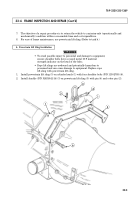TB-9-2320-335-13-P - Page 434 of 680
TB 9-2320-335-13&P
32-4
32-4. FRAME INSPECTION AND REPAIR (Cont'd)
1.
Visual inspection: This is the first and most critical step in deciding whether to repair or replace a
damaged frame component. Factors to be noted in visual inspection:
(a) Transverse tears, cracks, and breaks that extend over one tangent or radius and into 5/32 in.
(3.97 mm) of an associated tangent or radius must be replaced.
(b) Transverse tears, cracks, or breaks that extend over the tangent or radius can be repaired by
welding and reinforcing, providing the crack does not extend into 5/32 in. (3.97 mm) of an
associated tangent or radius.
(c) Tears, cracks, or breaks on the inside face of the frame rail that extend to within 3 in. (76.2
mm) of a bolted-on crossmember are unrepairable, and frame rail must be replaced.
(d) Tears, cracks, or breaks that extend into a hole or from a hole in the frame rails must first
have a dye penetrant test performed at the hole to determine if secondary cracks exist (refer
to TC 9-237). Secondary cracks are repairable. (See task c.1.)
(e) Tears, cracks, or breaks that extend into a hole or from a hole that does not have any existing
secondary cracks may be repaired by welding with the use of a pre-drilled reinforcement
(dutchman/fishplate) (refer to task e.).
(f)
Short longitudinal cracks (up to 6 in. (15.2 cm)) or split welds can be repaired by installing a
reinforcement (dutchman/fishplate) and heli-arc welding.
(g) Twisted frame rails are unrepairable; replace.
2.
Measurements: Select a smooth, level surface with area 1-1/2 times the size of the vehicle.
(a) Vertical (or side view) measurement:
(1) Raise vehicle at four points until all four wheels are off the surface (TM 9-2320-387-24-1).
WARNING
Shim material must be under jackstand. Do not use shims on top
of jackstand. Vehicle could be knocked off jackstand, causing
personnel injury or damage to equipment.
(2) Measure height to bottom of frame near each jackstand. Place shim(s) under jackstands as
necessary until all four heights are equal.
NOTE
Measurements must be taken at identical locations on left and
right frame rails. Failure to do so will result in faulty indication.
(3) Select, measure, and record frame rail height at several different positions on either frame
rail.
(4) Measure and record frame rail height at corresponding points on opposite frame rail.
(5) Right and left frame rail comparable points deviating more than 1/8 in. (3 mm) for each 2 ft
(.6 m) linear distance indicate a vertically bent frame. Record deviations.
NOTE
If measured frame rails are out of tolerance, notify supervisor. If
frame rails are verified to be out of tolerance, vehicle will be
classified as unserviceable.
(6) Lower vehicle from jackstands (TM 9-2320-387-24-1).
c. Inspection
Back to Top




















